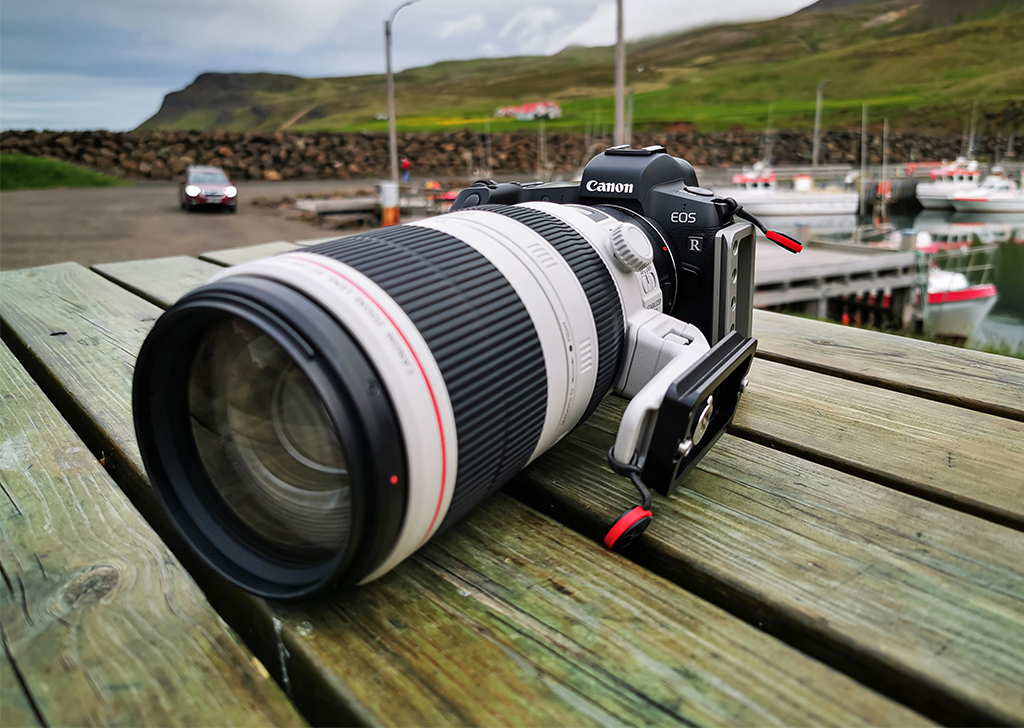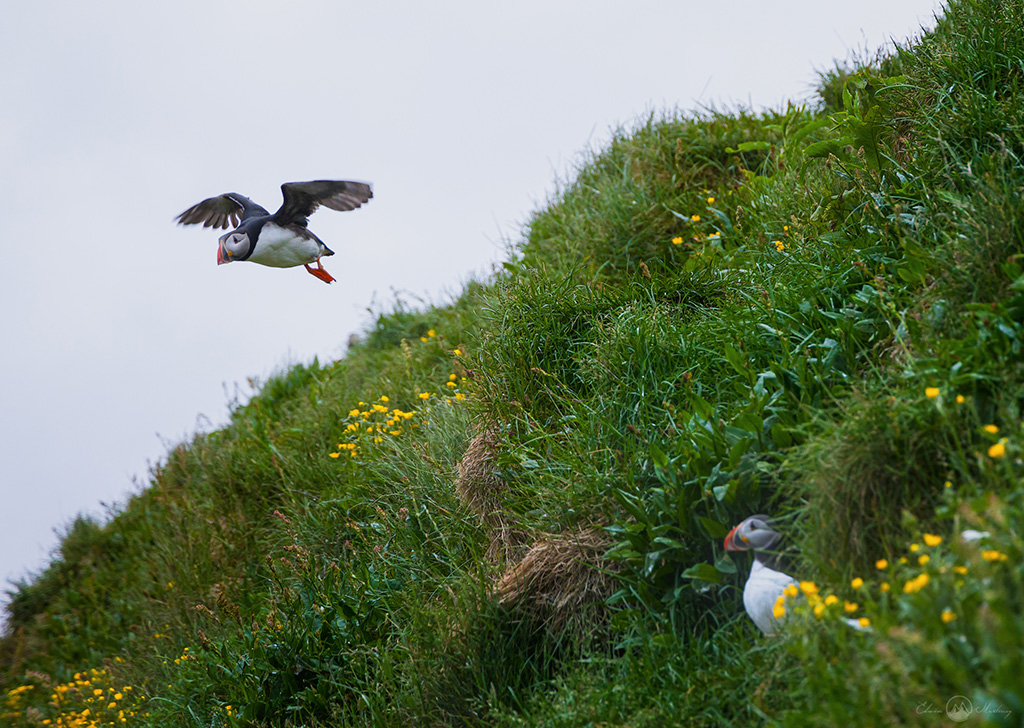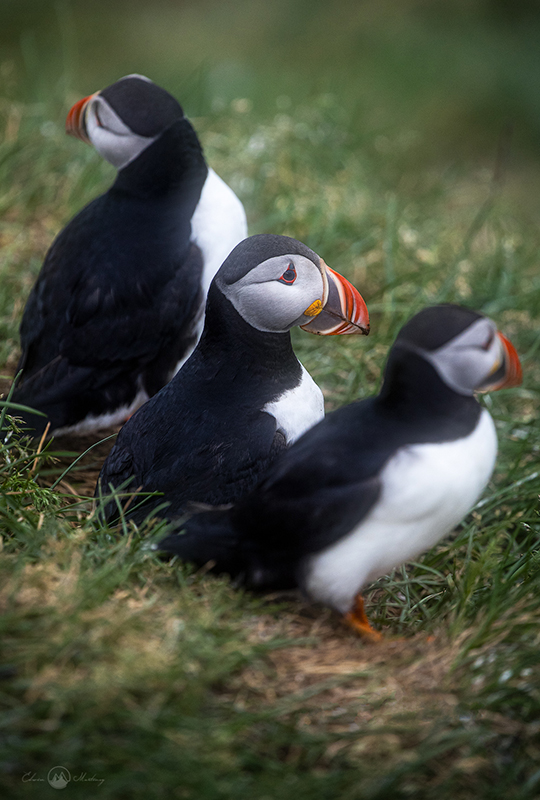Discover How Photographer Edwin Martinez Shoots Atlantic Puffins with EOS R
Iceland is more than just volcanoes and glaciers, and nature photographer Edwin Martinez can tell you that. Edwin spent the summer in Iceland photographing Atlantic puffins, a species of seabird in the auk family. While Atlantic puffins are native to the Atlantic Ocean, they spend their breeding season in Iceland and other countries close by. Edwin tells us more about his trip and the experience photographing these amazing creatures.

EOS R, EF100-400mm f/4.5-5.6L IS II USM lens, f/5.6, 400mm, 1/2500 sec, ISO1600
Tell us about your trip to Iceland and the thought process behind it.
Summer, with never-ending sunlight, is always a magical time to visit Iceland. Sunsets and sunrises are just an hour apart. Colours are also more vibrant due to the flowers blooming and the lava moss showing off its various shades of green; it is the opportune time to photograph the Atlantic puffins.
Iceland is the breeding ground to about 60 percent of the world's Atlantic puffins. Puffins can be seen in Iceland from early April to September each year. I have experienced all four seasons in Iceland and summer is one of my favourites because of this emblematic animal in the country.
Our tour took us to the east where there is a large colony settling in Borgarfjörður Eystri, the capital of the elves, as the Icelandic coined it. We timed our visit during feeding time which was around 5:00pm to 8:00pm, and one would be able to photograph them with fish in their mouth and also in flight.

EOS R, EF100-400mm f/4.5-5.6L IS II USM lens, f/4.5, 124mm, 1/1600 sec, ISO1600
What is your equipment and preferred settings when photographing the Atlantic Puffins?
It is always a good idea to have two camera bodies when photographing these puffins – one with a telephoto zoom lens (Canon EF100-400mm) and another with a mid-telephoto lens like an EF24-105mm. If you only have one body, the EF24-105mm lens would be the more flexible one. But reach is always king when photographing birds, and most of my intimate puffin shots were taken with the EF100-400mm lens. Finally, a fast camera with reliable focusing and frame per second is a must.
I chose the Canon EOS R, which comes with a Dual Pixel on-sensor autofocus system and with over 5,655 AF positions covering 88% frame horizontally and 100% vertically. The sheer number of AF positions is really attractive.

In photographing birds, you can choose between the TV (Shutter Priority) or AV (Aperture Priority) mode. I prefer photographing them in AV mode and setting my ISO to automatic but configure to a maximum of ISO 1600 only, to prevent higher ISO noise (minimum shutter speed [1/250 sec to 1 sec] can also be set so that the automatically-set shutter speed is not too slow). You should also tweak your focusing options (One-Shot AF / Servo AF) depending on what you want to achieve. For birds in flight, I usually tweak my focusing to get sharper results.

EOS R, RF24-105mm f/4L IS USM lens, f/4.0, 105mm, 1/2000 sec, ISO800
What are the three main things a nature photographer should possess?
As an outdoor and nature photographer, one must have the following;
Love for nature and the great outdoors. It is the inherent factor that drives your passion to see the world and photograph it. This should be first even before photography, and capturing them in your frame is just a reward.
Patience and persistence. Photographing the outdoors requires a lot of patience, and you are at the mercy of nature and have no control over the weather and light. Sometimes I would come back to a single location for more than five times just to get the perfect sunset.
A system you can rely and trust. It goes without saying that an archer can perform more with better equipment. I have been relying on the Canon system for years and have always trusted them on extreme conditions especially when the shot matters.

EOS R, EF100-400mm f/4.5-5.6L IS II USM lens, f/5.6, 400mm, 1/1600 sec, ISO1600
What is the one thing that people who view these photos would not know about?
For the most part of the year, Atlantic puffins live in the open ocean, they only fly and stay on the land during mating and nesting. Also, did you know that puffins are excellent fliers? Flapping their wings at up to 400 beats per minute, puffins can reach speeds of 88 km/h (55mph). Photographing them in flight is a challenge and you need to anticipate their direction. Another cool thing about puffins is that they are monogamous, they return to the same burrow during nesting and usually end up with the same mate.

EOS R, RF24-105mm f/4L IS USM lens, f/4.0, 105mm, 1/2000 sec, ISO800
How important is framing and what can you tell us about it?
Photographing birds is not just documenting them, you have to apply visual design and frame dynamics. It will be hard and sometimes cropping is a must because you are after the moment. One tip is to give space in your frame when photographing them – try not to have a tight shot, this will give you the flexibility to creatively crop later in post-production. Photographing static puffins will be easy, with their colourful beaks and wide eyes, and you can use colours as a natural frame and as an anchor point. I usually find an angle to include the grass and flowers to accentuate the already beautiful puffins.

EOS R, EF100-400mm f/4.5-5.6L IS II USM lens, f/5.6, 400mm, 1/1250 sec, ISO1600
To see more of Edwin’s work, check out the following articles:
Can the EOS R Survive the Harsh Winter in Canada?
A Photography Adventure in Iceland with Edwin Martinez
Capture the Magnitude of Landscapes with Edwin Martinez
Over the Land and Seas: Life of a Travel Photographer
Receive the latest update on photography news, tips and tricks.
Be part of the SNAPSHOT Community.
Sign Up Now!About the Author
Travel and Nature Photographer
When one speaks of travel and landscape photography at its apex, his name quickly comes to mind. Well known locally and gaining recognition abroad for his ethereal landscape images, his works exemplify landscape photography as a fine art.
A former medical and corporate professional, Edwin has found his niche and true calling in landscape photography. Still imbibed with the commitment and dedication for always achieving his best, these qualities are now his staples, whether he is shooting for clients or himself, mentoring photographers that join him in the tours that he guides in Iceland, Norway, Canada, the American west and other parts of the world or teaching in workshops under Wide Horizon Photo Adventure (https://www.facebook.com/WideHorizonPhotoAdventure)
Edwin’s excellence has been recognized by brands that support his projects. By virtue of his acknowledged skill and influence, he has been tapped to field test and help in the launch of a number of new photography gear. His works have graced both local and overseas publications and websites. Edwin’s images surely speak the language that draws attention and leaves an indelible mark of excellence.
To connect with or learn from Edwin, visit his social media accounts:
Introductory video: https://youtu.be/EvZrbGv4ENc
Facebook: www.facebook.com/EdwinMartinezPhotography/
Instagram page: https://www.instagram.com/edwinmartinez/
500px: https://500px.com/edwinmartinez
Youtube: https://www.youtube.com/edwinmartinezphotography
Website: https://edwinmartinezphotography.wpcomstaging.com/info/
https://500px.com/EdwinMartinez
http://edwinmartinezphoto.com/




































